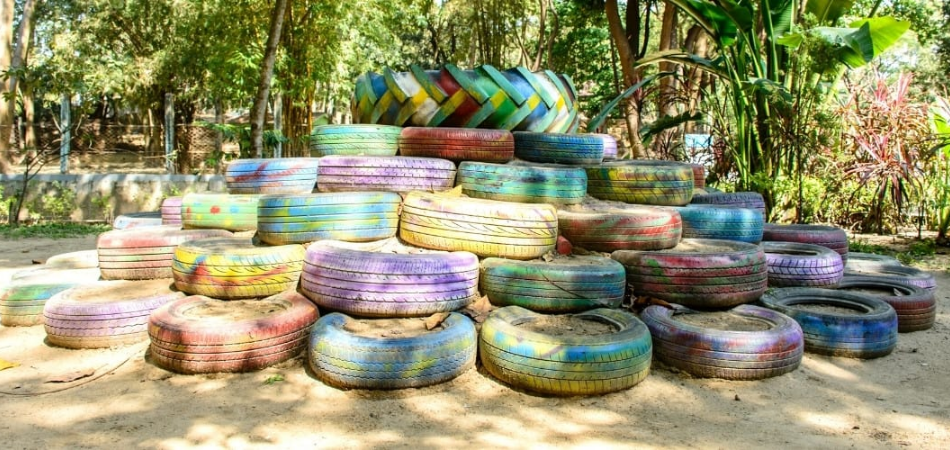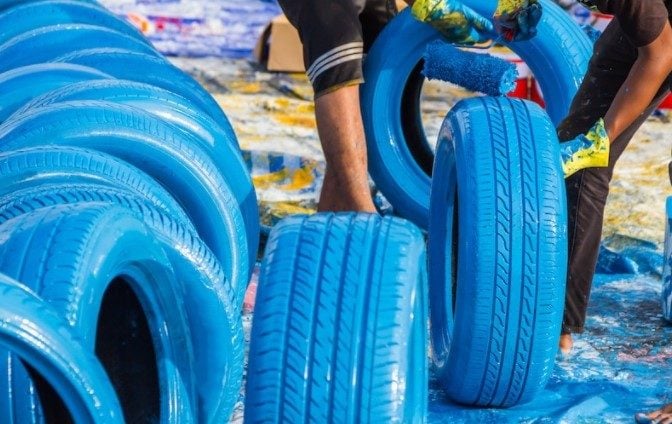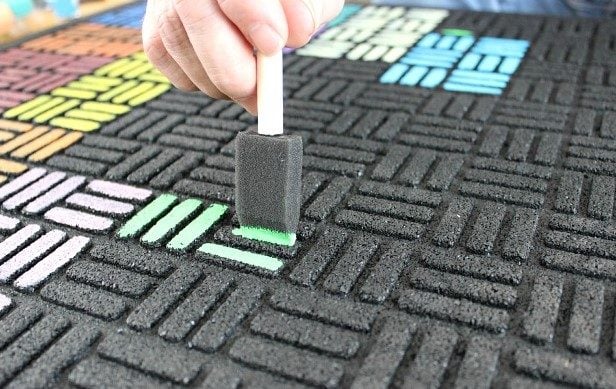Randy Charles is the owner of PaintCentric.com, a website dedicated to providing information, tips, tricks, and news about all things paint. With over 10 years...Read more
Rubber paint is a fab way to add colour and texture to your projects! You can get all kinds of rubber paint, each with its qualities. Here we’ll talk about the advantages and disadvantages of each, plus tips on how to pick the best one for your project. Get ready to get creative!

Definition of rubber paint
Rubber paint is designed for rubber surfaces. It comes in a range of colours. This makes it perfect for creating custom effects on rubberized apparel and accessories. The paint is waterproof and durable. It is great for interior and exterior applications.
Rubber paint can be applied with spray cans, brushes, or rollers. If you use spray cans, you’ll get great coverage. You can use brushes and rollers for bigger projects. Using two coats of latex-based primer before applying the paint is best. That will help the paint stick better.
When selecting rubber paint, consider
- durability and
- colourfastness.
Not all varieties will last long when outdoors or in water. Check if the product is waterproof and non-toxic. That could make a difference.
What Types of Rubber Paint Are Available?
Rubber paint is the perfect way to add vibrancy and protection to all your rubber materials. What type of rubber paint you should use depends on the type of rubber and the effect you want to achieve. There are lots of different types of rubber paint!
For example:
- Epoxy
- Polyurethane
- Silicone
In this article, we’ll explore the types of rubber paint and how to apply them.
Water-Based Rubber Paint
Water-based rubber painting is becoming a hit. People are more aware of environmental concerns. This type of paint is like the traditional solvent-based paints but has no VOCs. It also creates a better finish and is better at resisting fading from UV rays. Plus, it can be used indoors and outdoors, which makes the coating last longer. Clean-up is simpler, too, as water and soap will do. Plus, there is less prep time before application than solvent-based paints.
Oil-Based Rubber Paint
Oil-based rubber paint is a mix of oil and synthetic rubber. It’s great for adhesion and flexibility on rubber surfaces. It dries fast, is tough, resists UV and chemicals and stands up to weathering. It comes in many colours, such as black, white, grey, and earth tones like sandstone and Arizona tan.
Water-based rubber paint is an alternative. It’s perfect for indoors or places where smell or the environment are important. It has low VOCs, low odour and superb adhesion. It won’t crack, chip or wear away over time. It comes in various colours, including some that protect against UV or give a textured finish for playgrounds.
Acrylic Rubber Paint

Acrylic rubber paint is a great choice for painting rubber or other materials. Irrespective of size or condition, this paint provides superior waterproof protection for synthetic rubber, metal, plastic, balloons and other playthings. It is easy to use and can be applied in multiple coats for vibrant colours and deep saturation levels. When fully cured, it offers excellent resistance against sunlight, wind, rain, and all types of wear and tear.
Plus, it comes in various colours that suit any painting purpose, inside and outside.
Latex Rubber Paint
Latex rubber paint is a water-based and non-toxic type of paint. It’s often used on surfaces that need waterproofing, like showers or walls. It contains an acrylic emulsion and a thickener for water coverage. It also has biocide agents to repel mildew and fungus. It comes in gloss, semi-gloss, or satin finishes. It provides better coverage than oil-based paint.
Latex rubber paint is durable and easy to clean with soap and warm water. Some brands offer specially formulated products for colour retention in kitchens and bathrooms.
Benefits of Using Rubber Paint
Rubber paint is a hit with homeowners and contractors! It’s durable and reliable. It can be used on lots of surfaces. It doesn’t wear away or stain easily. Plus, it protects against UV rays. And it dampens sound and keeps your home insulated.
Let’s take a closer look at the advantages of rubber paint:
Durability
Painted rubber surfaces are super long-lasting. Some paints can even last up to 10 years! The paint creates a waterproof barrier so the material can brave any weather. It also stops fading and discolouration from UV light or bad weather.
Rubber paints stick to materials regular paints can’t, like damp surfaces or those exposed to extreme temperatures. This way, it can protect materials and equipment from wear and tear, helping them last longer.
Flexibility
Rubber is special – it’s both flexible and durable. So, it’s perfect for car tires, playgrounds and exercise mats. It’s safe for the environment and people, so it’s often used for child toys, medical products and food items like ice cube trays. Plus, it has strong sticking power. So, you can expect its colour to remain vibrant over time – no chips or fading!
Easy to Clean
Rubber paints are awesome! They protect and make rubber surfaces look cool. Plus, they’re easy to clean. Because rubber paint is non-porous, it is resistant to all sorts of stuff like water, dirt, oil, and grime – no more scrubbing!
It’s perfect for playgrounds, as it is highly visible and easy to keep clean. Furthermore, the non-porous nature also resists mould and mildew. And rubber paint is super resistant to fading and chalking. So, it’s ideal for outdoor applications that must look great and last long.
Application Tips
To paint rubber, you need the correct paint and careful application. There are many kinds of rubber paints – each with its properties and perks. Here are some tips to get the most out of rubber paint:
- Get the right paint.
- Be precise when applying it.
- Look out for any unique characteristics.
Preparing the Surface
Surface preparation is key for a long-lasting paint job. Cleaning, sanding and priming are the processes involved.
- Cleaning: Dirt, debris and bacteria must be removed. Use heavy-duty soap, warm water and a brush on tough dirt. Detergent and sponge can be used on wood. Metal needs wire brushing or sandpapering to remove rust.
- Sanding: Imperfections and old paint must be lightly sanded. Use a fine-grade (400) paper with light pressure. Move the hand in parallel strokes using long motions.
- Priming: Must be applied after sanding/cleaning. Primers protect and provide a bond for paints requiring multiple coats. Oil or latex primers must be selected according to the wall substrate. Latex is generally easier and dries faster than oil-based.
Choosing the Right Paint

Choosing paint for rubber is key. Rubber is porous, so you need paint rated for rubber. There are two types: oil-based and acrylic latex. Oil-based is great for waterproofing but can crack if not applied correctly. Acrylic latex gives an even layer but may not work outdoors.
Before painting, think about temperature, humidity and sun exposure. Also, clean the surface and mask off other areas. That way, you’ll get the job done right!
Applying the Paint
When painting rubber, choose your paint with care. Permanent paints may be too harsh since rubber is a soft material. Use semi-permanent or rubber-based paints!
- Prep the surface by lightly sanding and wiping away the dust before beginning.
- Use synthetic fibres with a brush or roller and apply even strokes in thin layers.
- Sand lightly between coats with very fine grit sandpaper.
- Smooth out any bubbles or lines created.
- Finally, protect your paint job with two coats of sealer created specifically for rubber surfaces. This will guard against fading or cracking due to weather and age.
Conclusion
All done! You can paint rubber surfaces with spray, brush, or speciality rubber paints. But first, always make sure the surface is clean and dry. Pick the product for your needs, and try all the colours in a small, unseen area. Lastly, the final coat should guarantee adhesion and endure fading or cracking due to bad weather or heat.
Follow the manufacturer’s instructions and stay safe while using these products.
Frequently Asked Questions
What types of rubber paint are available?
Several types of rubber paint are available, including acrylic, epoxy, and urethane-based paints. Additionally, specific rubber paints are designed to be used on specific types of rubber.
What is the best type of rubber paint to use in 2023?
In 2023, the best type of rubber paint to use is urethane-based paint. Urethane-based paints are the most durable and best protect rubber surfaces best.

Randy Charles is the owner of PaintCentric.com, a website dedicated to providing information, tips, tricks, and news about all things paint. With over 10 years of experience in the painting industry, Randy has become an expert in the field and is passionate about helping others learn more about painting. He has written numerous articles on the subject and is committed to providing accurate and up-to-date information to his readers.
- Latest Posts by Randy Charles
-
How Much Do You Tip Painters? The Ultimate Guide
- -
Can You Paint Over Rust Converter?
- -
Can You Paint Inside When It Is Raining?
- All Posts
